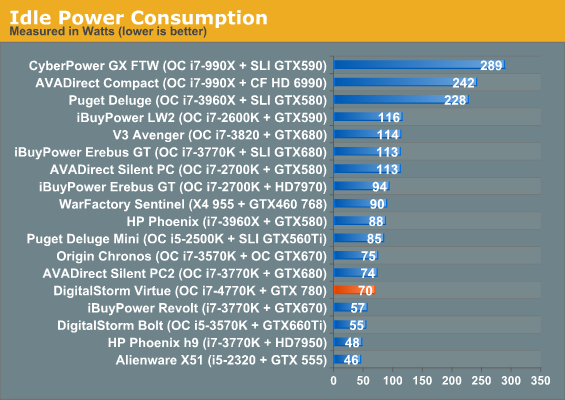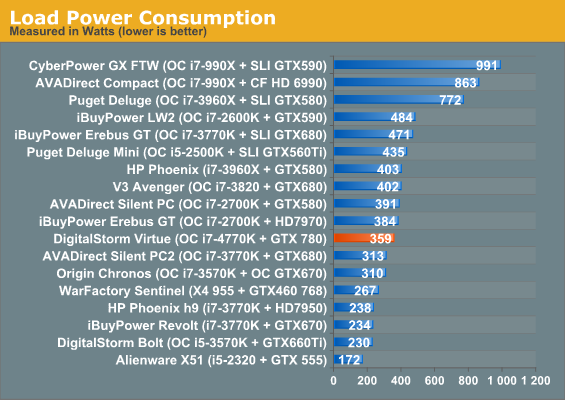Haswell and GK110 vs. Ivy and GK104: DigitalStorm Virtue System Review
by Dustin Sklavos on June 23, 2013 12:00 PM ESTBuild Quality
It's not entirely fair to DigitalStorm not to mention the generally excellent job they've done with the build quality of the Virtue. One of the ways a boutique can distinguish itself is in its component selection, and the stock component choices of the Virtue line are solid across the board.
Starting with the chassis selection, I'm actually a pretty big fan of the Corsair Obsidian 350D and I'm happy to see it being employed in a high performance system. Interestingly, DigitalStorm is also using Corsair's H100i to cool the CPU, but they're not employing Corsair Link software to control fan speed despite the system being wired to use it. Instead, the fans on the H100i (oriented beneath the radiator to pull in air from the top of the enclosure and then cycle it out of the rear exhaust) run at a fixed fan speed. I personally find variable fan speed to be distracting; I'd just as soon the whole system run silent all the time, end of discussion. DigitalStorm's choice here works for me.
.jpg)
The 350D also does an excellent job of showing off NVIDIA's reference cooler for the GeForce GTX 780, complete with the subtly glowing "GeForce GTX" logo. That's plugged into an ASUS Z87 Gryphon motherboard, and the system drive is a healthy 120GB Corsair Neutron GTX featuring an LAMD controller. Given all the Corsair kit in the Virtue, though, I'm actually surprised the memory is A-Data.
Where I'd be tempted to shake down DigitalStorm is in using a single stable voltage for overclocking the i7-4770K, but without more experience with Haswell and the quirks of its VRM I can't say if that's worth caring about or not. With the first generation chips (Nehalem, Clarksfield, Gulftown), this was a huge issue, but Sandy and Ivy were less problematic and it looks like Haswell is even less so. I do want to point out that DigitalStorm has traditionally been more aggressive about their CPU voltages than I'd like, but the i7-4770K's 1.28V is actually pretty common and totally reasonable.
Noise and Heat
Demonstrating a healthy amount of balance in their design, the Virtue isn't especially silent but is generally a touch quieter than enthusiast gaming desktops tend to be. Idle noise is around ~33dB, and since the CPU and chassis fans run at a fixed speed, the GeForce GTX 780 is really the only component that spins up or down. Unfortunately, while the 350D is an excellent case for liquid cooling, it does suffer slightly from Corsair's perpetual issues with middling air cooling performance.

Thermals on the GTX 780 are pretty par for the course, but it can jack noise levels up a couple of dB under sustained load. Meanwhile, the i7-4770K is really about where it needs to be. A more adventurous user might be able to eke a little more performance out of it with a little more juice, but I'd hesitate to push the H100i that much harder, especially without bumping the fan speeds up to a potentially uncomfortable volume.
Power Consumption
So how much power does a modern high end gaming system pull from the wall? The last couple of generations from Intel, NVIDIA, and AMD (Bulldozer/Piledriver notwithstanding) have all done an admirable job of continually reducing idle and load power consumption alike, so the DigitalStorm Virtue stands to benefit from those advances.


And it does. While neither one is abnormally spectacular, they're both totally reasonable. I'm not convinced DigitalStorm couldn't shave 10W or so off the idle power, but load power is where it ought to be.


_thumb.jpg)
_thumb.jpg)
_thumb.jpg)
_thumb.jpg)
_thumb.jpg)
_thumb.jpg)








70 Comments
View All Comments
JimmiG - Tuesday, June 25, 2013 - link
You *will* be able to pay extra for a properly TIM'ed CPU but it won't be another $20. You'll be looking at the IB-E and upcoming Haswell-E which will be several hundred more than their LGA1150 equivalents, with more expensive motherboards thrown in for good measure.airmantharp - Monday, June 24, 2013 - link
So, 1000W PSU's are just for shits and giggles? It couldn't draw more than 500w in the worst load situations, and 750W PSU's covering dual-GPU setups are far more reasonable.danjw - Monday, June 24, 2013 - link
Any chance you could be convinced to see what you could do by deliding the i7-4770K changing the internal TIM, and see what you can do with it? I would really like to find out what the real top end to Haswell is, without Intel's nerf.Ubercake - Tuesday, June 25, 2013 - link
This is kind of a creative way to give Haswell a numeric boost. How about both systems with 780s? Probably not much of a difference whatsoever.When AMD starts creating meaningful CPUs again, we'll see Intel get back into competition mode. Until then, they'll just keep selling CPUs with ever-so-slight increases.
Klimax - Tuesday, June 25, 2013 - link
I doubt we'll ever again see GHz race, because energy density is getting very high .(Smaller chip is, more heat per mm needs to be transferred)And without huge complexity, per-clock performance is walled too. (And GPU show how such complexity works with yields)
AndersP - Tuesday, June 25, 2013 - link
If you choose to buy a 780 GTX over a 770 GTX, you gain 10-20% performance increase for 70% higher price.You have to pay 20% more if you choose to buy 770gtx SLI rather than a single 780 GTX for a 50-60% performance increase. In addition, a 770 GTX is a lot cheaper, faster and better temperatures than 680 GTX. Not sure, about new features such as shadowplay and automated performance/temperature control also works with older models.
In my eyes 770 GTX is defiantly very viable. If you want the most for your buck.
godrilla - Tuesday, June 25, 2013 - link
My 3 year old rig with i7 980 xe at 4.3 ghz and 1 year old gtx 690 1150/6500 mhz is still top notch.halcyon - Wednesday, June 26, 2013 - link
These kind of meagre performance upgrades are the reason I'm not upgrading. Yes, I have the cash. In fact, it's burning in my pocket.But a 10% or so improvement at best over what I have?
Even my secondary 2009 system has a 3-channel memory subsystem that can actually feed four cores, unlike Haswell chipsets.
GTX670 and GTX770 offer almost zip improvements for my CUDA based workload.
But I'm not complaining, I can spend this money on better digigams, new phone, new tablet, etc.
At least there have been _substantial_ improvement on those, unlike in CPU/GPU performance of the past years.
Bluejay234 - Monday, July 22, 2013 - link
As good as the Digital Storm build looks, the sad truth is that there is STILL no compelling reason to buy a new Digital Storm system, when the 2600k based one I bought at the beginning of 2011 is almost as powerful as anything I can get today (and overclocks better).Drittz121 - Friday, February 28, 2014 - link
Just do yourself a favor. STAY AWAY from this company. Yes they look good. But when it breaks and it WILL. All they do is give you the run around. They have had my system for over 2 months trying to fix the garbage they sell. Worse company out there for support. DONT BUY